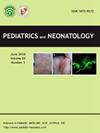通过体素形态测量法研究非先天性心脏病对儿童大脑的影响:病例对照研究。
IF 2.1
4区 医学
Q2 PEDIATRICS
引用次数: 0
摘要
背景:大量研究表明,紫绀型先天性心脏病(CHD)患者在手术过程中会出现脑损伤,但对非紫绀型先天性心脏病儿童的术前神经发育和脑损伤却不甚了解。本研究的目的是利用体素形态计量学(VBM)研究非紫绀型先天性心脏病儿科患者在导管手术前整体和局部灰质(GM)体积的变化:方法:对住院治疗的1至3岁无囊性先天性心脏病幼儿(n = 54)进行了前瞻性登记。每个幼儿在导管手术前都接受了三维 T1 加权脑磁共振成像(MRI)扫描。同时,对年龄和性别匹配的健康对照组(35 人)的三维 T1 加权脑磁共振成像进行了回顾性分析。用 SPM 12(统计参数绘图软件)中的 VBM 评估了 GM 体积和颅内总体积(TIV),并用双样本 t 检验和家族误差(FWE)率校正分析了 GM 体积的区域差异:结果:两组幼儿的GM总体积和TIV均无差异(P>0.05),但VBM分析显示,与对照组相比,非青光眼CHD组幼儿的额中回(两侧)、额下回、眶回、胼胝体下回、丘脑(两侧)、苍白球内侧(两侧)和culmen(两侧)的GM结构均有所减少(P1-3岁患有无囊性先天性心脏病的幼儿在接受导管手术前局部GM体积会减少,且往往分布在双侧额叶、丘脑、球状苍白球和小脑。本文章由计算机程序翻译,如有差异,请以英文原文为准。
Impact of non-cyanotic congenital heart disease on Children's brain studied by voxel-based morphometry: A case-control study
Background
Considerable research has shown brain injury during surgery for patients with cyanotic congenital heart disease (CHD), but the preoperative neurodevelopment and brain injury in children with non-cyanotic CHD are not well understood. The aim of this study is to investigate changes in global and local grey matter (GM) volumes of pediatric patients with non-cyanotic CHD before catheter-based procedure using voxel-based morphometry (VBM).
Methods
One-to three-year-old toddlers with acyanotic CHD (n = 54) hospitalized for treatment were prospectively enrolled. Each toddler underwent a 3D T1-weighted brain Magnetic Resonance Imaging (MRI) scan before catheter-based procedure. Meanwhile, 3D T1-weighted brain MR images of age- and sex-matched healthy controls (n = 35) were retrospectively analyzed. The volume of GM and total intracranial volume (TIV) were assessed by VBM within the SPM 12 (Statistical Parametric Mapping software), and regional differences in GM volume were analyzed by two-sample t-test and familywise error (FWE) rate correction.
Results
There was no difference in gross GM volume and TIV between the two groups (p > 0.05), but VBM analysis showed reduced structures of GM in middle frontal gyrus (both sides), inferior frontal gyrus, orbital gyrus, subcallosal gyrus, thalamus (both sides), medial globus pallidus (both sides) and culmen (both sides) of the non-cyanotic CHD group compared with the controls (p < 0.05, FWE correction).
Conclusion
Toddlers aged 1–3 years with acyanotic CHD suffer a decrease in local GM volume before catheter-based procedure, which tends to be distributed across the bilateral frontal lobe, thalamus, globus pallidus, and cerebellum.
求助全文
通过发布文献求助,成功后即可免费获取论文全文。
去求助
来源期刊

Pediatrics and Neonatology
PEDIATRICS-
CiteScore
3.10
自引率
0.00%
发文量
170
审稿时长
48 days
期刊介绍:
Pediatrics and Neonatology is the official peer-reviewed publication of the Taiwan Pediatric Association and The Society of Neonatology ROC, and is indexed in EMBASE and SCOPUS. Articles on clinical and laboratory research in pediatrics and related fields are eligible for consideration.
 求助内容:
求助内容: 应助结果提醒方式:
应助结果提醒方式:


